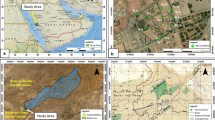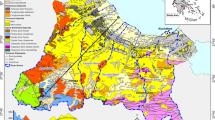Abstract
The purpose of this study was to determine and evaluate the spatial changes in the depletion of groundwater level differences by using geostatistical methods based on data from 58 groundwater wells during the period from April 1999 to April 2008 in the study area. Geostatistical methods have been used widely as a convenient tool to make decision on the management of groundwater levels. To evaluate the spatial changes in the level of the groundwater, geographic information system is used for the application of universal kriging method with cross-validation leading to the estimation of groundwater levels. The resulting prediction mappings identify the locations of groundwater level fluctuations of the study area. The average range of variogram (spherical model) for the spatial analysis is about 9,200 m. Results of universal kriging for groundwater level differences drops were underestimated by 15 %. Cross-validation errors are within an acceptable level. The maps show that this area of high decrease of groundwater level is located at the southwest. Kriging model helps also to detect sensitively risk prone areas for groundwater withdrawing. Such areas must be protected with an effective management procedure for future groundwater exploitations.







Similar content being viewed by others
References
Ahmadi SH, Sedghamiz A (2007) Geostatistical analysis of spatial and temporal variations of groundwater level. Environ Monit Assess 129:277–294
Basaran M, Erpul G, Ozcan AU, Saygin DS, Kibar M, Bayramin I, Yilman FE (2010) Spatial information of soil hydraulic conductivity and performance of cokriging over kriging in a semi-arid basin scale. Environ Earth Sci. doi:10.1007/s12665-010-0753-6
Bugai D, Kashparov V, Dewiere L, Khomutinin Y, Levchuk S, Yoschenko V (2005) Characterization of subsurface geometry and radioactivity distribution in the trench containing Chernobyl clean-up wastes. Environ Geol. 47:869–881
Cameron K, Hunter H (2002) Using spatial models and kriging techniques to optimize long-term ground-water monitoring networks: a case study. Environmetrics 13:629–656
Castrignano A, Buondonno A, Odierna P, Fiorentino C, Coppola E (2008) Uncertainty assessment of a soil quality index using geostatistics. Environmetrics. doi:10.1002/env.930
Chappell A, Heritage GL, Fuller IC, Large ARG, Mılan DJ (2003) Geostatistical analysis of ground-survey elevation data to elucidate spatial and temporal river channel change. Earth Surf Proc Land 28:349–370
Cinnirella S, Buttafuoco G, Pirrone N (2005) Stochastic analysis to assess the spatial distribution of groundwater nitrate concentrations in the Po catchment (Italy). Environ Pollut 133–3:569–580
Desbarats AJ, Logan CE, Hinton MJ, Sharpe DR (2002) On the kriging of water table elevations using collateral information from a digital elevation model. J Hydrol 255:25–38
D’Agostino V, Greene A, Passarella G, Vurro M (1998) Spatial and temporal study of nitrate concentration in groundwater by means of coregionalization. Environ Geol 36:285–295
Diodato N, Ceccarelli M (2005) Interpolation processes using multivariate geostatistics for mapping of climatological precipitation mean in the Sannio Mountains (southern Italy). Earth Surf Process Landf 30:259–268
Dong J, Yu M, Bian Z, Wang Y, Di C (2010) Geostatistical analyses of heavy metal distribution in reclaimed mine land in Xuzhou. China. Environ Earth Sci. doi:10.1007/s12665-010-0507-5
Fischer MM, Scholten HJ, Unwin DJ (1996) Spatial analytical perspectives on GIS. Taylor & Francis Ltd, London
Gaus I, Kinniburgh DG, Talbot JC, Webster R (2003) Geostatistical analysis of arsenic concentration in groundwater in Bangladesh using disjunctive kriging. Environ Geol 44:939–948
Gundogdu KS, Guney I (2007) Spatial analyses of groundwater levels using universal kriging. J Earth Syst Sci 116(1):49–55
Hu K, Huang Y, Li H, Li B, Chen D, White R (2005) Spatial variability of shallow groundwater level, electrical conductivity and nitrate concentration, and risk assessment of nitrate contamination in North China Plain. J Environ Int 31:896–903
Isaaks E, Srivastava RM (1989) An introduction to applied geostatistics. Oxford University Press, New York
Journel AG, Huijbregts CJ (1978) Mining geostatistics. Academic Press, London
Knotters M, Bierkens MFP (2001) Predicting water table depths in space and time using a regionalised time series model. Geoderma 103:51–77
Kumar V, Remadevi TT (2006) Kriging of groundwater levels—a case study. J Sp Hydrol 6:81–94
Iskandar I, Koike K (2010) Distinguishing potential sources of arsenic released to groundwater around a fault zone containing a mine site. Environ Earth Sci. doi:10.1007/s12665-010-0727-8
LaMotte AE, Greene EA (2007) Spatial analysis of land use and shallow groundwater vulnerability in the watershed adjacent to Assateague Island National Seashore, Maryland and Virginia, USA. Environ Geol 52:1413–1421
Lee JY, Song SH (2007) Evaluation of groundwater quality in coastal areas: implications for sustainable agriculture. Environ Geol 52:1231–1242
Leuangthong O, McLennan JA, Deutsch CV (2004) Minimum acceptance criteria for geostatistical realizations. Nat Resour Res 13:131–141
Liao D, Peuquet DJ, Duan Y, Whitsel EA, Dou J, Smith RL, Lin HM, Chen JC, Heiss G (2006) GIS approaches for the estimation of residential-level ambient PM concentrations. Environ Health Perspect 114:1374–1380
Liu CW, Jang CS, Chen SC (2002) Three-dimensional spatial variability of hydraulic conductivity in the Choushui River alluvial fan, Taiwan. Environ Geol 43:48–56
Nas B, Berktay A (2006) Groundwater contamination by nitrates in the city of Konya. J Environ Manag 79:30–37
Rakhmatullaev S, Marache A, Huneau F, Coustumer PL, Bakiev M, Le P, Heino MM (2010) Geostatistical approach for the assessment of the water reservoir capacity in arid regions: a case study of the Akdarya reservoir. Uzbekistan. Environ Earth Sci. doi:10.1007/s12665-010-0711-3
Shamsudduha M, Marzen LJ, Uddin A, Lee MK, Saunders JA (2009) Spatial relationship of groundwater arsenic distribution with regional topography and water-table fluctuations in the shallow aquifers in Bangladesh. Environ Geol 57:1521–1535
Sharda VN, Kurothe RS, Sena DR, Pande VC, Tiwari SP (2006) Estimation of groundwater recharge from water storage structures in a semi-arid climate of India. J Hydrol 329:224–243
Sunila R, Kollo K (2007) A comparison of geostatistics and fuzzy applications for digital elevation models. Quality aspects in spatial data mining. Wiley, London
Ta’any RA, Tahboub AB, Saffarini GA (2009) Geostatistical analysis of spatiotemporal variability of groundwater level fluctuations in Amman–Zarqa basin, Jordan: a case study. Environ Geol 57:525–535
Theodossiou N, Latinopoulos P (2006) Evaluation and optimization of groundwater observation networks using the kriging methodology. Environ Model Softw 21:991–1000
Wameling A (2003) Accuracy of geostatistical prediction of yearly precipitation in Lower Saxony. Environmetrics 14:699–709
Wang YQ, Zhang XC, Zhang JL, Li SJ (2009) Spatial variability of soil organic carbon in a watershed on the Loess Plateau. Pedosphere 19(4):486–495
Water Authority (2006) Groundwater Report 2006 Konya. Turkey, Municipality of Konya City (in Turkish)
Wu C, Wu J, Luo Y, Zhang H, Teng Y, DeGloria SD (2010) Spatial interpolation of severely skewed data with several peak values by the approach integrating kriging and triangular irregular network interpolation. Environ Earth Sci. doi:10.1007/s12665-010-0784-z
Yarus JM, Chambers RL (1994) Stochastic modeling and geostatistics. In: AAPG computer applications in geology, vol 3. The American Association of Petroleum Geologists
Yeh MS, Lin YP, Chang LC (2006) Designing an optimal multivariate geostatistical groundwater quality monitoring network using factorial kriging and genetic algorithms. Environ Geol 50:101–121
Author information
Authors and Affiliations
Corresponding author
Additional information
Handling Editor: Ashis SenGupta.
Rights and permissions
About this article
Cite this article
Uyan, M., Cay, T. Spatial analyses of groundwater level differences using geostatistical modeling. Environ Ecol Stat 20, 633–646 (2013). https://doi.org/10.1007/s10651-013-0238-3
Received:
Revised:
Published:
Issue Date:
DOI: https://doi.org/10.1007/s10651-013-0238-3




